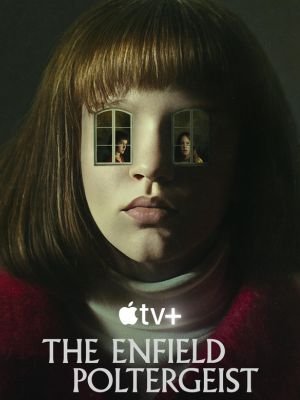
AppleTV+’s recent supernatural documentary series The Enfield Poltergeist is rooted in the same claimed haunting as that of 2016’s The Conjuring 2. However, there are some surface similarities between them: mystifying knocks on walls at night, a scared little girl dressed in a red nightgown, and a ghost called Bill who swears he passed away while sitting on an armchair in the lounge nearby. However, one distinguishing factor nicely demonstrates the distinction between these two approaches to events at 284 Green Street North London from 1977 through to 1979; you know, The Conjuring 2 is scary.
Not that The Enfield Poltergeist doesn’t have its moments. For instance, director Jerry Rothwell and his crew utilized original field recordings of the phenomenon with chilling effect. Some of this audio includes creepy visuals such as dark images of shadows moving around children’s bedrooms and stairs with just light bulbs at the top bare. Some of it features actors lip-synching dialogue recorded by apparent lookalikes for parts they’d play out live.… These give it a strange feel.
However, this documentary is not scary like James Wan movies are usually scary. There are no bangs or knocks coming from outside the view; therefore the scares’ timings lack sufficient expertise for jumping up from your seat when watching. Instead it moves like a real-life paranormal investigation would do – which means subtly but disturbingly apart from screaming kids- or gradually rather than abruptly if you want to be kind about it (though after four hours those re-enactments become quite repetitive).
To move things along, The Enfield Poltergeist presents doubts about whether or not poltergeist activity really took place around eleven-year-old Janet Hodgson in her family’s small working class house. In early talking-head interviews, neighbours and other witnesses all claim that what they saw all those years ago was paranormal. “I believe I talked to a ghost,” says Richard Grosse, the son of psychic investigator Maurice Grosse, in an episode 2 sees him speaking soberly into the camera.
However, by episode 4, one of Janet’s cousins has dialed back the rhetoric: “It was real at the time for me.” The Enfield poltergeist case is among the most well-documented haunting in history; as such, during the eighteen months when Bill terrorized them almost every night and they lived in their council house, various newsmen and scientific (or pseudo-scientific) investigators appeared on the premises. Most prominently among these was Grosse who according to one of his colleagues at a very proper British Society for Psychical Research was “a complete bloody nuisance”. Grosse who worked as an inventor and mechanical engineer died in 2006 but has some extracts from his diary read by former ex-colleagues here. At first he had been skeptical but he soon became convinced that Janet and her family were being tormented by real spirits.
But not all were convinced by this argument. For example, Psychologist Anita Gregory (also late and also a companion at SPR) argues that the phenomenon is best understood when placed within the family dynamic in which it occurs. Several interviewees accept that the Hodgson household was “tense,” but The Enfield Poltergeist does not ask what is clearly a sensitive question. Instead, there arises an abundance of other bizarre theories such as telekinesis, parallel universes, cursed furniture or haunted birds; alongside another more simple one: Janet made up everything to get attention.
These possibilities of what might have actually happened reveal that just one individual can provide answers to these inquiries being asked here and that person is none other than Janet herself. The huge amount of excitement over her entrance midway through episode three gets just about right fanfare, yet the way she comes into the room completely changes the course of the series.
Additional place-setting is done with vintage news clips and dub and punk tracks that establish the hopeless atmosphere of late-’70s England. But more importantly for style, they created 284 Green Street (plenty of photos and footage of which were captured, remember). It has so much in common with Kitty Green’s 2017 documentary Casting JonBenet where she also pulled back to show how fake all those lighting kits and sound stages were while investigating what is really “true.” Reporters, and witnesses like Janet or her sister Margaret go around such a set amazed by its likeness to real things.
The flimsiness characterizes The Enfield Poltergeist throughout. Towards this phenomenon, however, it shows some open-mindedness allowing it to focus on their emotions instead of either proving or disproving ghosts at last. Is this a cop-out? Maybe. Does it reflect accurately on real-life paranormal experiences? Definitely.
Verdict
AppleTV+’s new docuseries on one of Britain’s most famous (and well-documented) haunted-house cases uses original audio recordings and faithful re-creations to chilling effect. It starts out creepy, then gets repetitive, then ends on a note that doesn’t answer any of the series’ many questions but does leave an emotional impact.
Also, Read On Fmovies
